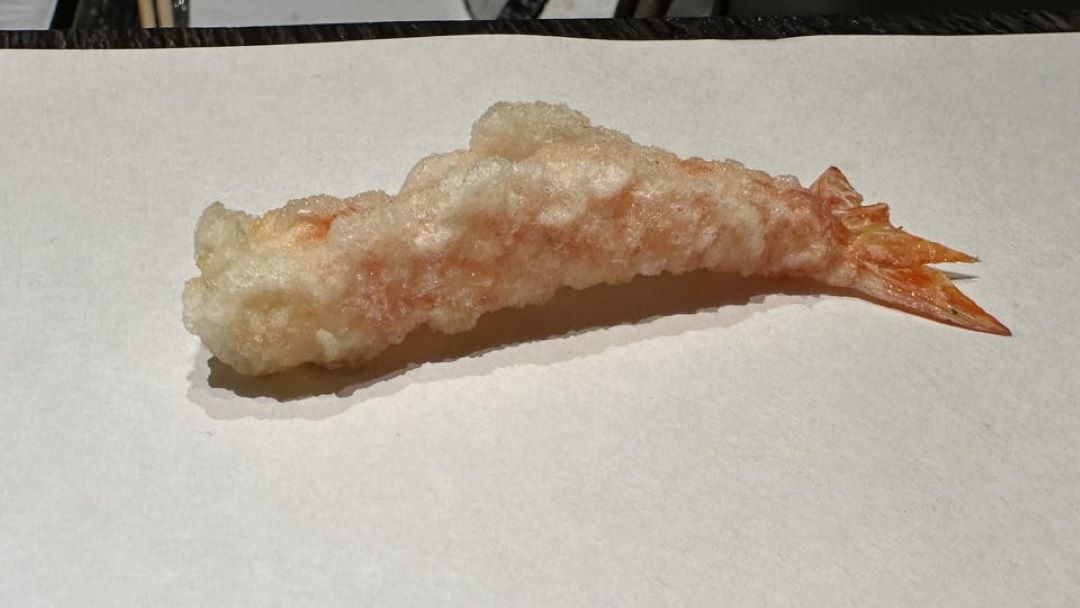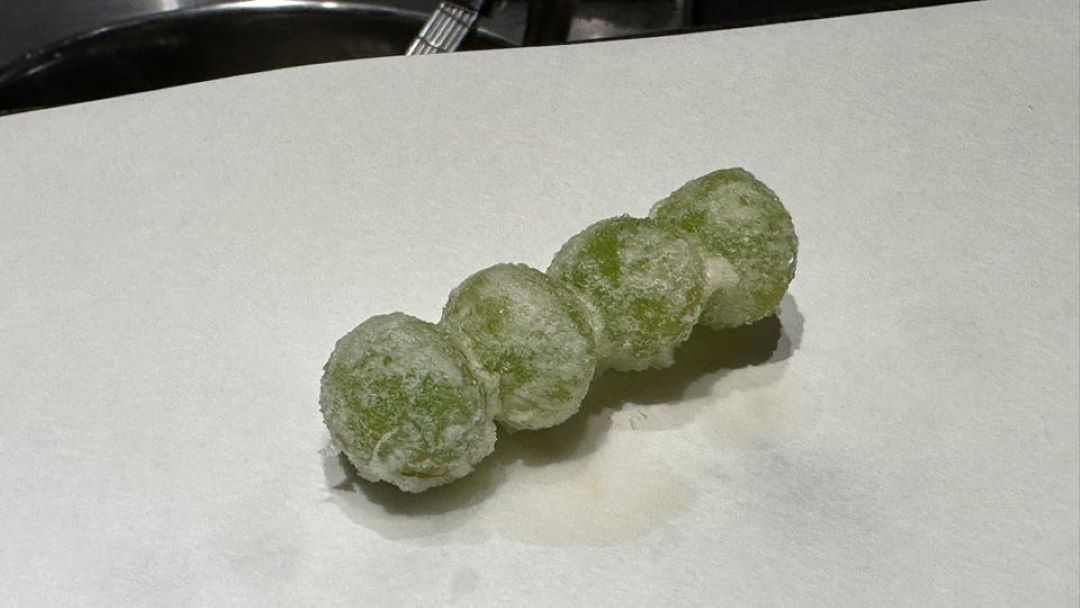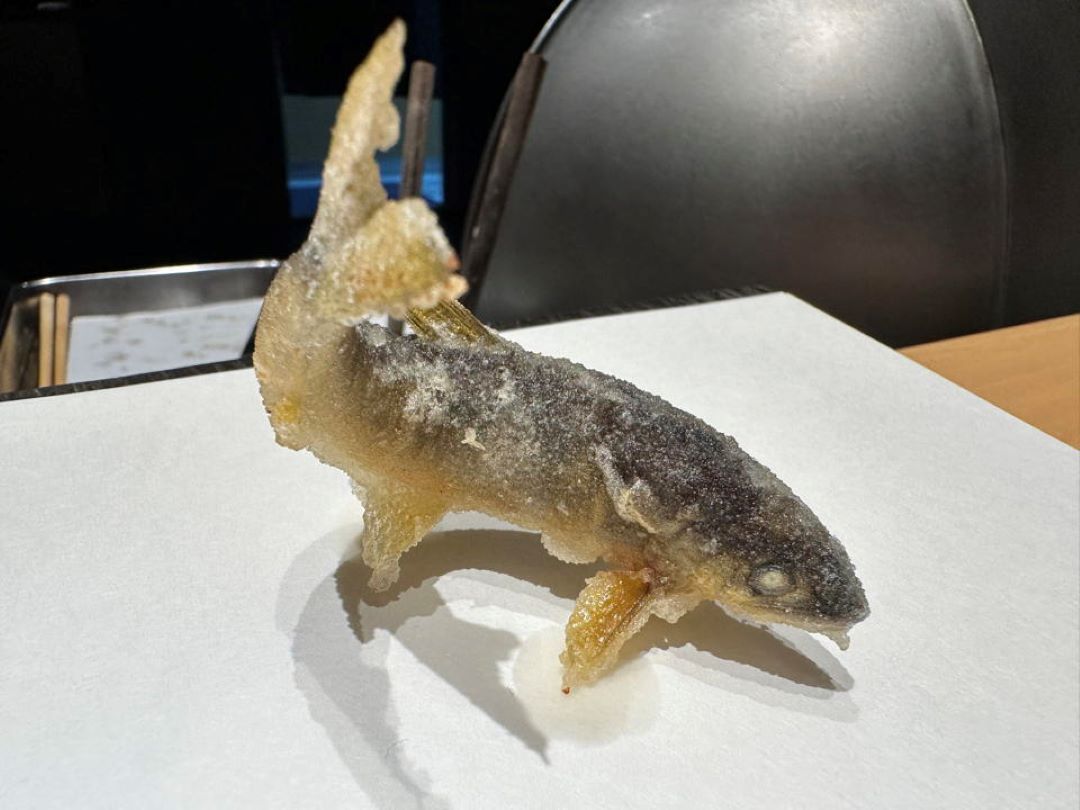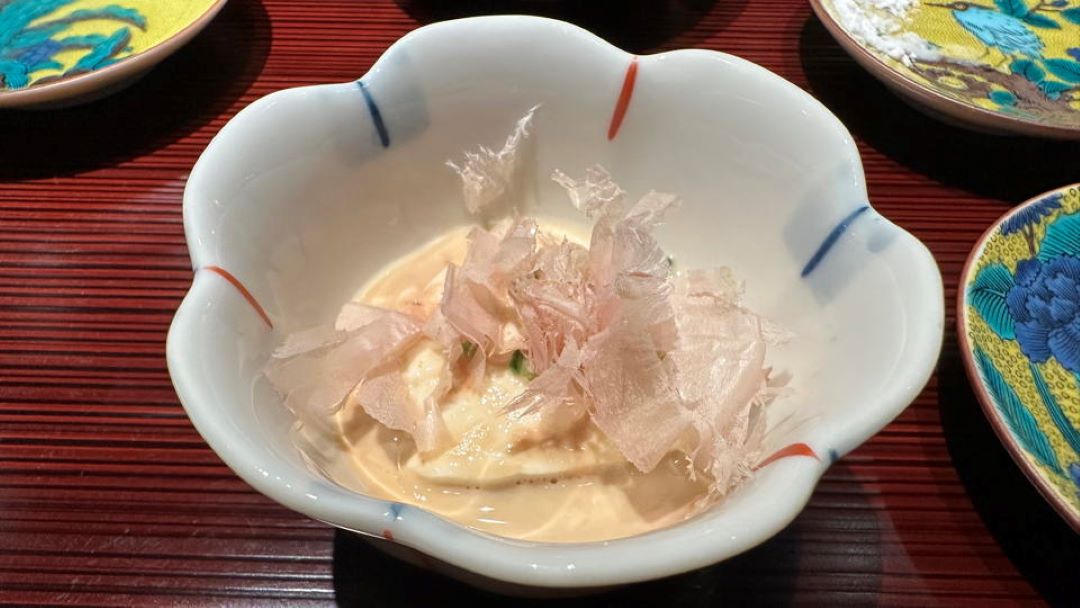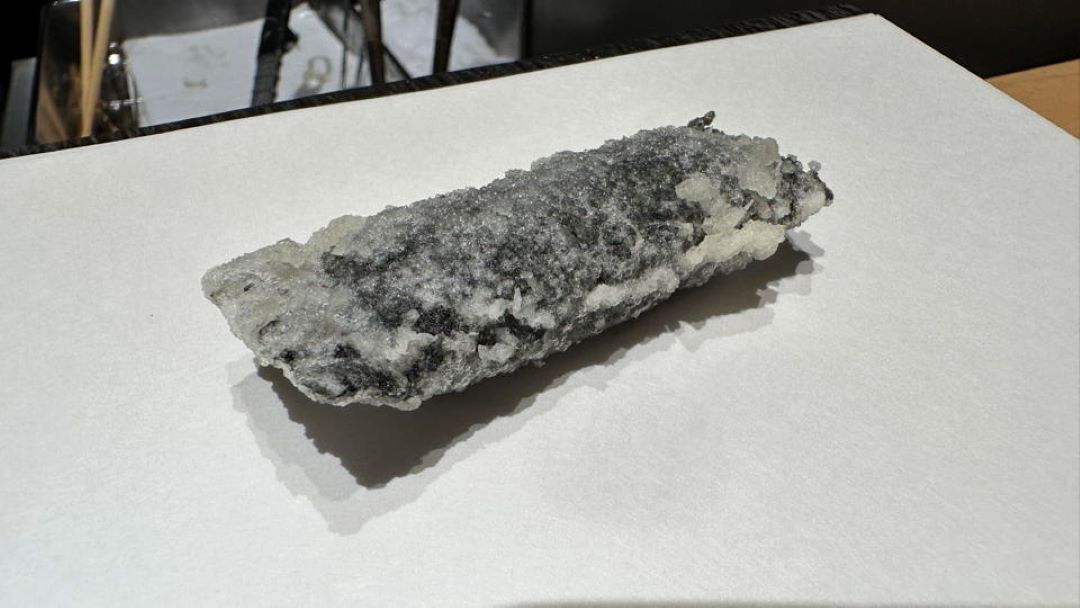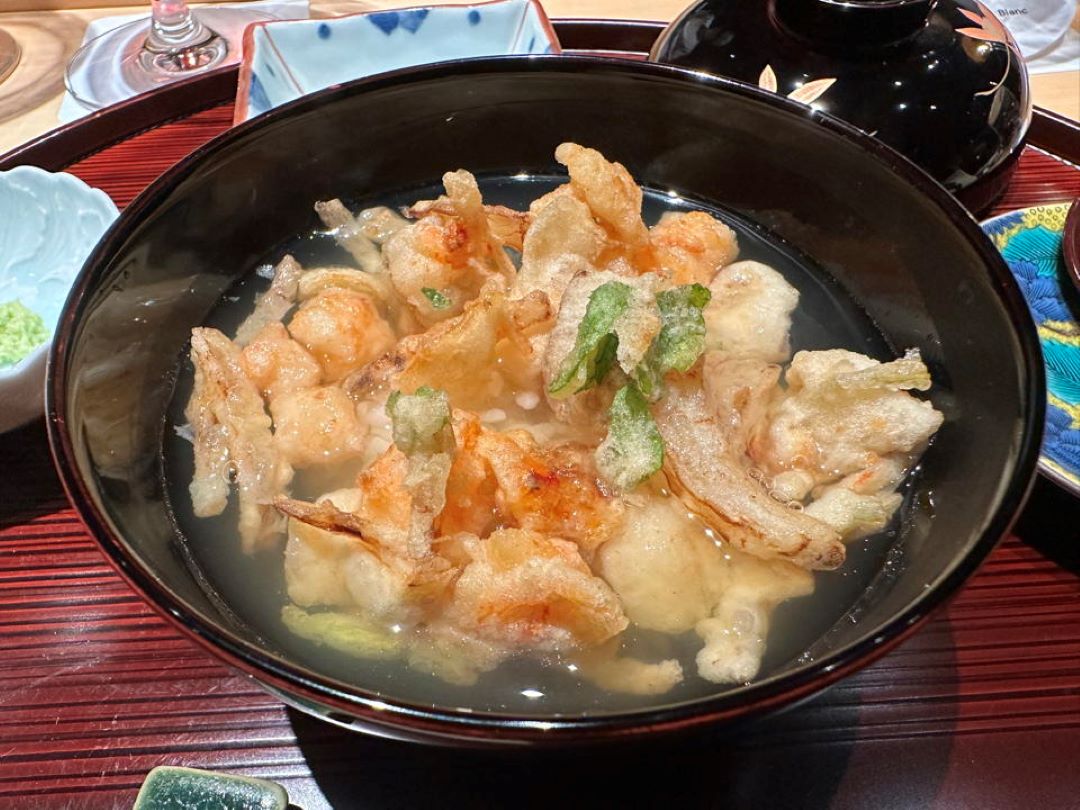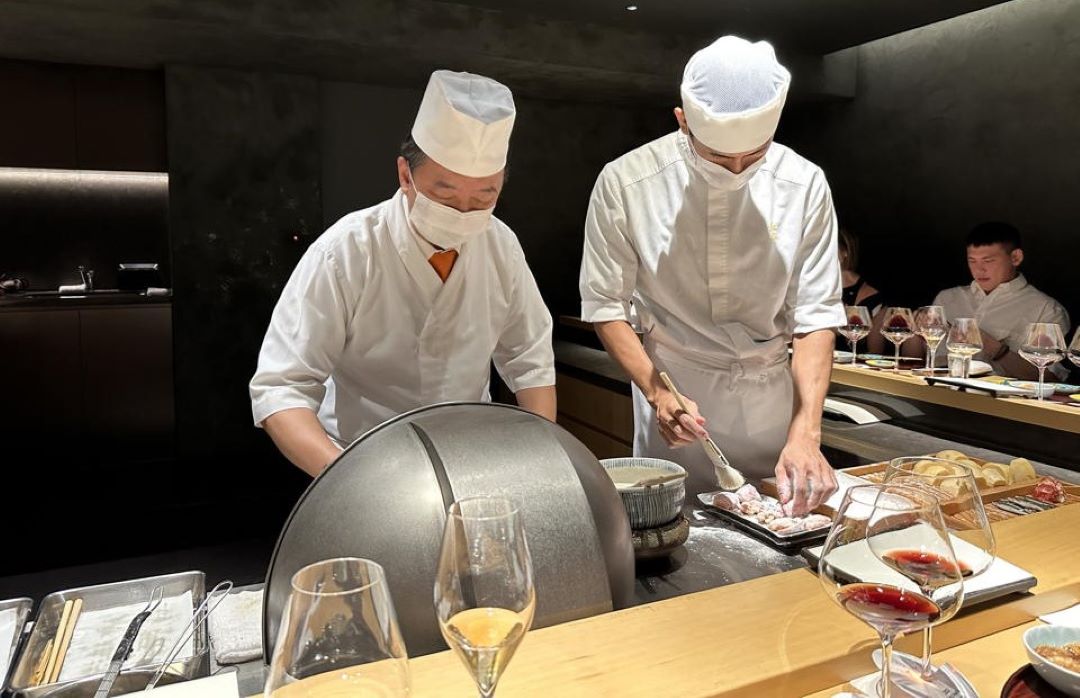Browse using the new Vinous website now. Launch →
Printed by, and for the sole use of . All rights reserved © 2015 Vinous Media
43號45號
Lane 10, Chengdu Rd
Wanhua District
Taipei City
Taiwan
BY NEAL MARTIN | FEBRUARY 14, 2025
The Food:
Abalone with udon, caviar and flowers
Grouper broth
Shrimp tempura
Kisu (Japanese whiting) tempura
Sea urchin with shiso leaf
Gingko tempura
Rosy sea bass tempura
Fresh lobster tempura
Taiwanese springfish
Tofu with fresh dashi and sesame
Ikura (salmon roe) tempura
Hachiya
Lotus root
Anago (Conger eel)
Satsuma imo (sweet potato)
Tsukemono (Japanese pickles)
Taiwanese oolong tea
The Wines:
1990 Pol Roger Cuvée Winston Churchill – 97
2017 Domaine Comte Georges de Vogüé Musigny Vieilles Vignes Blanc – 91
1993 Domaine Mugneret-Gibourg Ruchottes-Chambertin Grand Cru – 90
1996 Domaine Emmanuel Rouget Vosne-Romanée Cros Parantoux 1er Cru – 94
2002 Domaine Alain Hudelot-Noëllat Richebourg Grand Cru – 88
2003 Domaine de la Romanée-Conti Romanée-Saint-Vivant Grand Cru – 95
2010 Domaine Bizot Echézeaux Grand Cru – 86
2006 Domaine Dujac Romanée-Saint-Vivant Grand Cru – 93
2000 Domaine Leroy Clos de la Roche Grand Cru – 94
2006 Domaine du Comte Liger-Belair La Romanée Grand Cru – 97
2005 Domaine Ponsot Clos de la Roche Vieilles Vignes Grand Cru – 87?
1999 Domaine Comte Georges de Vogüé Musigny Vieilles Vignes Grand Cru – 90?
1999 Domaine Georges Roumier Bonnes-Mares Grand Cru – 95+
At its most fundamental level, Japanese cuisine is about elevating simplicity to its highest level. The ethos of Mudan Tempura takes that principle and runs with it. However, this restaurant is located neither in Tokyo nor Kyoto, not even Japan. Mudan is in central Taipei. Taiwan's strong affinity with Japan is deeply embroidered into its gastronomy. Driving through the city on my first and hopefully not last visit, I spotted numerous Japanese restaurants catering to most subgenres of cuisine. Mudan Tempura has two Michelin stars under its belt. Obtaining one of the restaurant’s coveted 16-or-so seats requires some perseverance. Nevertheless, for this special evening, we have the entire restaurant to ourselves, arranging long in advance to bring our own wines. There are two sittings each day, at 12:30pm and 6.30pm, and since there is only one cooking station, Mudan requests that guests arrive promptly, which is common amongst top Japanese restaurants.
The discreet sign on Mudan's façade.
The exterior is purposefully nondescript and designed along the lines of many a Japanese restaurant, like a coy geisha that wishes not to advertise her presence. Your trusty Google Maps should guide you to its front door as Mudan is located on a main thoroughfare, not down some dead-end alleyway. You enter a single room cast in tenebrous light dominated by a three-sided counter with the fryer stationed in the middle—the focal point for the entire evening. The décor is minimalist, just an ornate replica of maple hung on one of its walls, focusing attention on the only thing that matters: what you are about to eat. On this evening, the restaurant was staffed by one head chef and his young assistant, a bit like La Lune in Beaune. Everything here is about fastidious sourcing of ingredients, seasonality and nuance. One thing I should note is that the tempura here is known for its lighter coating. In some dishes, it is gossamer thin (the antithesis of a fish ‘n chips I recently ate in London that was 90% batter, 5% air and 5% that might have once had gills).
There are about 17 courses in a special menu designed for this evening. This is definitely one occasion where images say more than words, because nearly all the dishes are prepped and fried one by one. I have just added information with regard to sourcing—let’s just say Mudan would not win any sustainability awards given the air miles that some ingredients accumulated.
The chef told me that the abalone actually comes from South Africa. That’s a long way from Taiwan!
The grouper comes from the east of Taiwan and is served in a subtle, clear broth.
The shrimp oozes with sweetness and juiciness, this fella from Kagoshima in Japan.
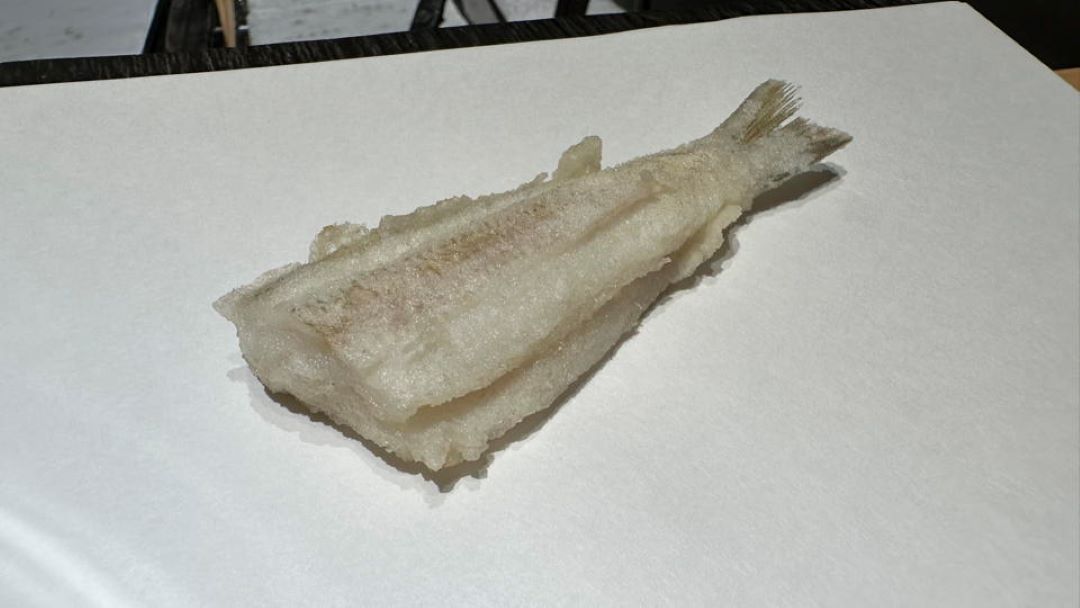
Kissing gourami is a fish native to Southeast Asia.
The sea urchin comes from Hokkaido and is served with shiso leaf.
Tempura gingko nuts
The rosy sea bass is a local Taiwanese fish.
Tempura of French lobster.
Springfish is known as “ayu” in Japan and is commonly served in Japanese
restaurants, though this one is native to Taiwan.
The tofu comes with a fresh dashi and sesame.
This ikura (salmon roe) is tinctured black, not from squid ink but from
seaweed.
This Satsuma-imo (sweet potato) was fried for 30 minutes. I don’t often
see them in the UK, but they are plentiful in Burgundy.
This bowl of rice comes with shrimp in a clear broth made from tea—so
nuanced in flavor.
This dessert uses lotus root powder from the chef’s hometown, mixed with a brown sugar sauce.
The theme for the fermented grape juice is Burgundy, although we begin in appropriate fashion with bubbles.
The 1990 Cuvée Winston Churchill from Pol Roger, poured from magnum, is a magnificent Champagne that is reaching its peak. It comes armed with an ethereal nose that unfolds with yellow fruit, hints of butterscotch and melted candlewax, boasting exquisite delineation and mineralité, perhaps with a sense of joie-de-vivre. The palate has a soft, pillowy texture, though there is a brisk acidic spine that lends this real tension. Possessing Balletic balance yet layered and caressing on the finish, this is a champagne that our wartime PM would have relished. There is just one white. The 2017 Musigny Vieilles Vignes Blanc from de Vogüé, which I would have last tasted in barrel with former winemaker François Millet, is quite powerful on the nose, in my mind, curiously Côte de Beaune-like in style. Given the growing season in question, I would have liked more tension and mineralité. The palate has a lovely, slightly waxy texture with notes of lemon thyme, lanolin and sliced white peaches toward the finish, though to be truthful, it doesn't quite convince that it is Grand Cru through and through. I probably prefer subsequent vintages.
The 1993 Ruchottes-Chambertin Grand Cru comes from an era when
the Mugneret sisters were still familiarizing themselves with winemaking
following the untimely passing of their father three years earlier. One can see
this as a work in progress. A little austere on the nose, it never quite
delivers the depth of fruit and concentration of a top Ruchottes. The palate is
medium-bodied with slightly "bony" tannins, a little disjointed in
style. It shows balsamic-tinged red fruit, with plenty of freshness with
pleasing piquancy on the finish. To be frank, this '93 is not a patch on
vintages produced in the last decade or so.
The 1996 Vosne-Romanée Cros Parantoux 1er Cru should be considered a success for the vintage for Emmanuel Rouget, delivering pure redcurrant intermixed with kirsch and orange blossom. Some background VA never really interferes. There’s fine delineation here—in fact, the aromatics gain precision with aeration—alongside an agreeable peaty scent. The palate is very well balanced with fine-boned tannins. Soy-tinged red fruit segues into blacker, tarry fruit toward the finish, which has a slight rambunctiousness you occasionally find among 1996 Côte de Nuits. This coheres beautifully in the glass. À point. The 2002 Richebourg Grand Cru from Domaine Hudelot-Noëllat is somewhat of a let-down in the scheme of things. Light leafy red fruit, bergamot and rose petals open, it just lacks the presence and density of a Richebourg. You want to say to it, “Stop shilly-shallying around!” The palate is medium-bodied with a touch of warmth, light tannins and some attenuation on the finish. Underwhelming.
The 2003 Romanée-Saint-Vivant Grand Cru from Domaine de la Romanée-Conti is a wine that I have not tasted since release. It acquits itself supremely well. Slightly deeper in hue than expected, it has a vibrant nose that brushes aside the notorious heat of that summer. Red fruit, candied orange peel, crushed stone and bay leaf are delineated and focused. The palate has excellent balance and tension. Quite finely chiseled tannins lend this RSV a sense of symmetry, with tart sour cherries adding tension and vibrancy on the finish. Exquisite. Yves Bizot’s 2010 Echézeaux Grand Cru fails to live up to the hype. I am led to believe that Bizot crafts far superior wines these days. Nevertheless, for the princely sum one pays these days, the 2010 has a nose that is subjugated by the oak barrel, obscuring all sense of terroir. The palate is actually better, with decent balance, black rather than red fruit and hints of brown spice, but again, the oak seems to be fumbled in the winery and renders the finish generic. The 2006 Romanée-Saint-Vivant Grand Cru from Domaine Dujac has a fragrant, well-defined bouquet with red cherries, crushed strawberries and a cheeky Muscat-like aroma. It is quintessentially RSV though with a possible tincture of botrytis? The palate is medium-bodied and a little riper than perhaps optimal, though a keen line of acidity provides a counterbalance. Quite sensual in style, the 2006 is cohesive with maybe just a slight lack of acidity in the final third. Perhaps it does need more mineralité, but you have to admire its purity and panache.
The 2000 Clos de la Roche Grand Cru from Domaine Leroy shows a little browning on the rim. It has a typical Leroy nose that you could argue overrides the terroir expression: sweet red fruit, tomato vine, rural Tuscan scents and hints of pine. It's not profoundly complex, but it is thoroughly enjoyable. The palate is medium-bodied with a sweet core of slightly candied fruit, silky smooth in typical Leroy fashion. Fully mature, with impressive transparency and a dash of allspice on the finish, this Clos de la Roche is drinking perfectly now. Whilst I maintain that Louis-Michel was finding his feet in his first decade at the helm of Domaine du Comte Liger-Belair, the 2006 La Romanée Grand Cru is perhaps his greatest success from his early period and augurs what followed. This is consistent with previous bottles: heavenly scent purity on the nose that seems to embrace and “cuddle” the olfactory senses, with layers of red and blue fruit, violet and peony. Stunning delineation. The palate is medium-bodied with a sumptuous texture and immense depth yet possesses elegance and poise. The satin mouthfeel is irresistible. The 2005 Clos de la Roche Vieilles Vignes Grand Cru from Domaine Ponsot does not fit the billing. Muddled on the nose and simplistic, it never comes near the quality of ethereal vintages like the 1980 or 1985. The palate is just as disappointing, and there is clear lack of Pinoté. The 2005 is a wine that seems unable to contend with the level of expectation heaped upon it. Thankfully, there are other superior vintages from Ponsot.
We finish back in Chambolle-Musigny. The 1999 Musigny Vieilles Vignes Grand Cru from de Vogüé doles out pure dark berry fruit commingling with melted tar. Maybe there's just a touch of TCA? The palate is medium-bodied with firm tannins, quite robust and missing a bit of grace. Certainly, it would not be my first port of call if seeking Pinoté. I wonder if this is enduring a dumb phase, but then again, it is now 25 years old. Finally, the 1999 Bonnes-Mares Grand Cru from Domaine Roumier is served alongside de Vogüé's Musigny and easily brushes it aside. The Bonnes-Mares has so much more finesse and mineralité than the Musigny, with pure wild strawberry and cranberry fruit, sensual and ripe. The palate is beautifully balanced and powerful, with filigree tannins and impressive density on the finish. It leans toward a more muscular style of Bonnes-Mares, and I would afford it another five or six years in bottle.
The chefs at Mudan Tempura were as friendly as they were talented.
Mudan Tempura is one of the finest tempura restaurants at which I have eaten, and I have eaten at many over the years. Interestingly, speaking to Taiwanese friends over the following weeks, I got the impression that whilst they admire the restaurant, it would not rank amongst the greats in Japan. They also lamented the price that for Taiwan is eye-wateringly expensive, though actually not outrageous when you compare it to some of London or New York’s destination restaurants. Nevertheless, I could observe the detail in every dish and appreciated that it is no po-faced temple where one has to sit in silent reverence to the chef. I found him chatty and affable, even though we had to resort to my terrible Japanese. I was only in Taiwan for a couple of nights, so I never really got to see the city and sample its culinary delights, but it certainly proved that the Taiwanese can take the tenets of Japanese cuisine and offer a top-quality dining experience.© 2025, Vinous. No portion of this article may be copied, shared or redistributed without prior consent from Vinous. Doing so is not only a violation of our copyright but also threatens the survival of independent wine criticism.




